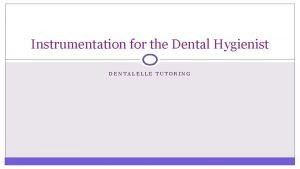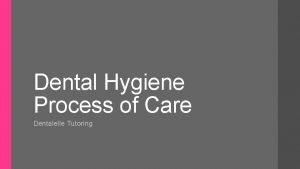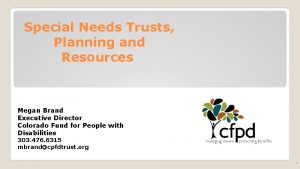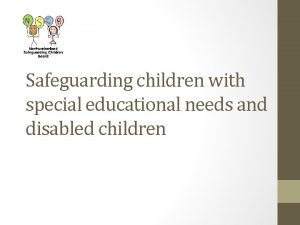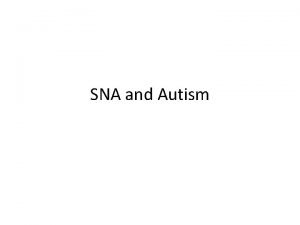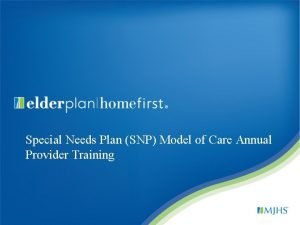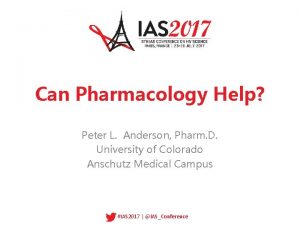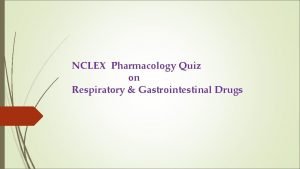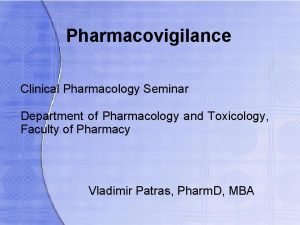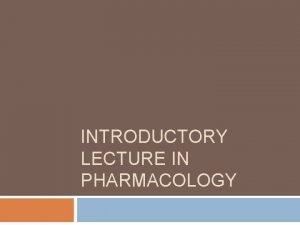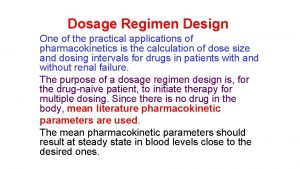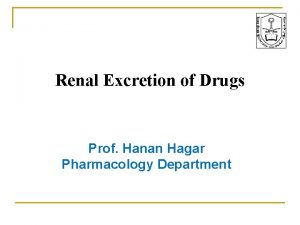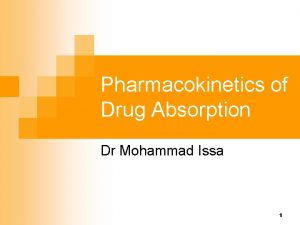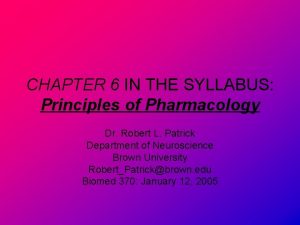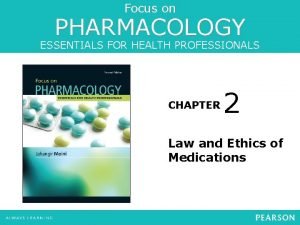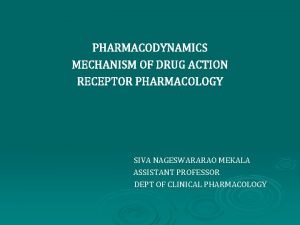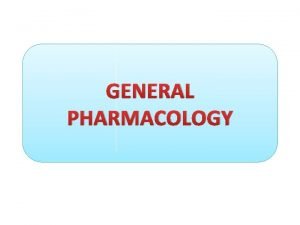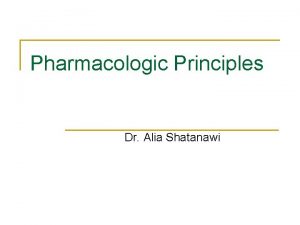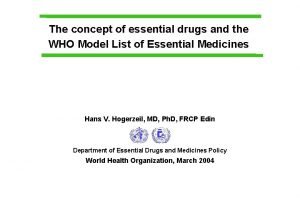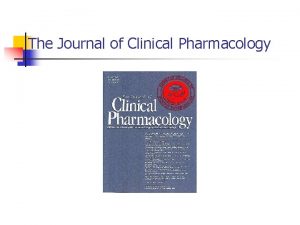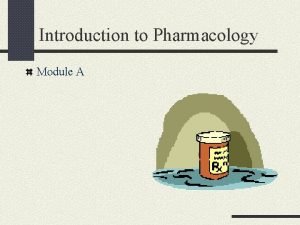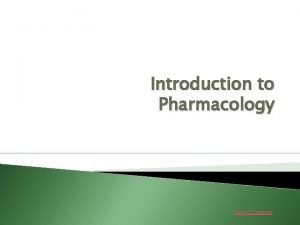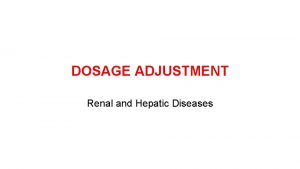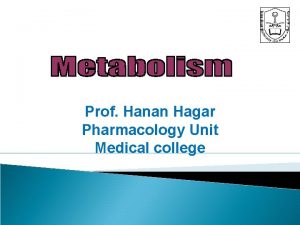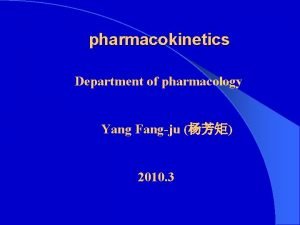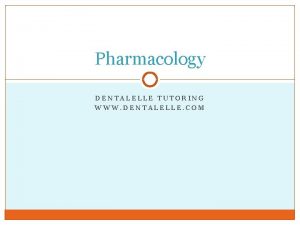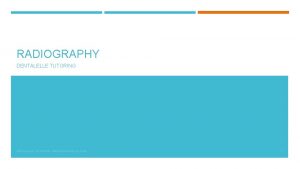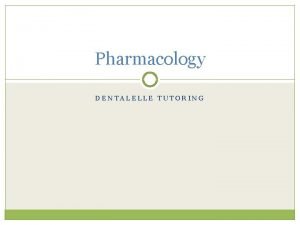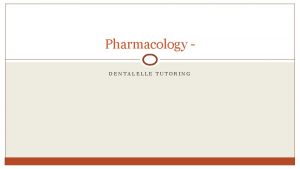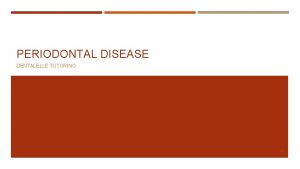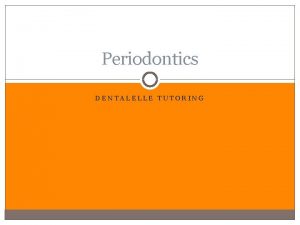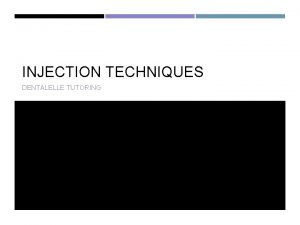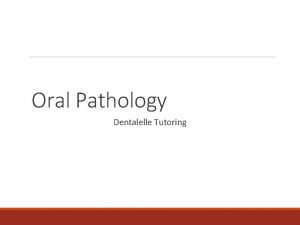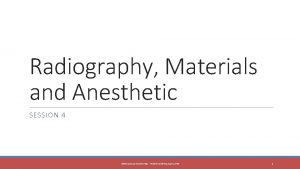PHARMACOLOGY PART II SPECIAL NEEDS DENTALELLE TUTORING WWW













































- Slides: 45

PHARMACOLOGY PART II SPECIAL NEEDS DENTALELLE TUTORING WWW. DENTALELLE. COM 1

HEART DISEASE DENTALELLE TUTORING WWW. DENTALELLE. COM 2

WHAT IS HEART DISEASE Heart disease describes a range of conditions that affect your heart. Diseases under the heart disease umbrella include blood vessel diseases, such as coronary artery disease; heart rhythm problems (arrhythmias); and heart defects you're born with (congenital heart defects), among others. The term "heart disease" is often used interchangeably with the term "cardiovascular disease. " Cardiovascular disease generally refers to conditions that involve narrowed or blocked blood vessels that can lead to a heart attack, chest pain (angina) or stroke. Other heart conditions, such as those that affect your heart's muscle, valves or rhythm, also are considered forms of heart disease. Many forms of heart disease can be prevented or treated with healthy lifestyle choices. DENTALELLE TUTORING WWW. DENTALELLE. COM 3

HOW OUR HEART WORKS Your heart is a pump. It's a muscular organ about the size of your fist, situated slightly left of center in your chest. Your heart is divided into the right and the left side. The division protects oxygen rich blood from mixing with oxygen poor blood. Oxygen poor blood returns to the heart after circulating through your body. The right side of the heart, comprising the right atrium and ventricle, collects and pumps blood to the lungs through the pulmonary arteries. The lungs refresh the blood with a new supply of oxygen. The lungs also breathe out carbon dioxide, a waste product. Oxygen rich blood then enters the left side of the heart, comprising the left atrium and ventricle. The left side of the heart pumps blood through the aorta to supply tissues throughout the body with oxygen and nutrients. DENTALELLE TUTORING WWW. DENTALELLE. COM 4

HEART VALVES Four valves within your heart keep your blood moving the right way by opening only one way and only when they need to. To function properly, the valve must be formed properly, must open all the way and most close tightly so there's no leakage. The four valves are: Tricuspid Mitral Pulmonary Aortic DENTALELLE TUTORING WWW. DENTALELLE. COM 5

OUR HEART A beating heart contracts and relaxes in a continuous cycle. During contraction (systole), your ventricles contract, forcing blood into the vessels to your lungs and body. During relaxation (diastole), the ventricles are filled with blood coming from the upper chambers (left and right atria). Your heart's electrical wiring keeps it beating, which controls the continuous exchange of oxygen rich blood with oxygen poor blood. This exchange keeps you alive. Electrical impulses begin high in the right atrium and travel through specialized pathways to the ventricles, delivering the signal for the heart to pump. The conduction system keeps your heart beating in a coordinated and normal rhythm, which keeps blood circulating. DENTALELLE TUTORING WWW. DENTALELLE. COM 6

THE RISKS Age. Aging increases your risk of damaged and narrowed arteries and weakened or thickened heart muscle. Sex. Men are generally at greater risk of heart disease. However, women's risk increases after menopause. Family history. A family history of heart disease increases your risk of coronary artery disease, especially if a parent developed it at an early age (before age 55 for a male relative, such as your brother or father, and 65 for a female relative, such as your mother or sister). Smoking. Nicotine constricts your blood vessels, and carbon monoxide can damage their inner lining, making them more susceptible to atherosclerosis. Heart attacks are more common in smokers than in non smokers. Poor diet. A diet that's high in fat, salt, sugar and cholesterol can contribute to the development of heart disease. High blood pressure. Uncontrolled high blood pressure can result in hardening and thickening of your arteries, narrowing the vessels through which blood flows. DENTALELLE TUTORING WWW. DENTALELLE. COM 7

RISKS CONTINUED High blood cholesterol levels. High levels of cholesterol in your blood can increase the risk of formation of plaques and atherosclerosis. Diabetes increases your risk of heart disease. Both conditions share similar risk factors, such as obesity and high blood pressure. Obesity. Excess weight typically worsens other risk factors. Physical inactivity. Lack of exercise also is associated with many forms of heart disease and some of its other risk factors, as well. Stress. Unrelieved stress may damage your arteries and worsen other risk factors for heart disease. Poor hygiene. Not regularly washing your hands and not establishing other habits that can help prevent viral or bacterial infections can put you at risk of heart infections, especially if you already have an underlying heart condition. Poor dental health also may contribute to heart disease. DENTALELLE TUTORING WWW. DENTALELLE. COM 8

HEART CONDITIONS Patients with certain heart conditions have a higher risk of endocarditis. It happens when bacteria in the bloodstream attach to damaged heart valves or other damaged heart tissue. In 2007, the American Heart Association updated its guidelines on the use of antibiotics before dental treatments. The new policy advises antibiotics for fewer conditions than the old policy did. Pre-treatment with antibiotics is still recommended for people who have had endocarditis in the past. It is also recommended for people with artificial heart valves, and people who had heart transplants and later developed heart valve problems. Pre treatment with antibiotics also is recommended for people with certain heart conditions that were present at birth: Cyanotic heart disease that has not been repaired or was repaired incompletely. This includes people with shunts and conduits. A heart defect that was completely repaired with a prosthetic material or device. In this case, antibiotics are advised only for the first six months after the procedure. Any repaired heart defect that still has some defect at or next to the site of a prosthetic patch or device DENTALELLE TUTORING WWW. DENTALELLE. COM 9

ANTIBIOTICS NOT RECOMMENDED FOR Taking antibiotics before dental treatment is no longer advised for people with: Acquired heart valve dysfunction (for example, rheumatic heart disease) Mitral valve prolapse Bicuspid valve disease Calcified aortic stenosis Congenital heart conditions, such as ventricular septal defect, atrial septal defect, and hypertrophic cardiomyopathy The American Heart Association guidelines recommend pre treatment antibiotics for dental procedures that involve an incision or manipulation of the gums or the tissues. **I always recommend checking the guidelines the MONTH you take your exam, the guidelines are constantly changing** DENTALELLE TUTORING WWW. DENTALELLE. COM 10

NOT NEEDED Antibiotics are not required for the following: Routine anesthetic injections through non infected tissue X rays Placement of dentures Placement or adjustment of removable orthodontic appliances Placement of the bracket part of braces (not bands) The natural loss of baby teeth in children Bleeding from trauma to the lips or mouth DENTALELLE TUTORING WWW. DENTALELLE. COM 11

MYOCARDIAL INFARCTION Heart attack Oral Effects A heart attack can sometimes feel like pain that starts in the chest and spreads to the lower jaw. Other times it may be pain that starts in the jaw or in the left arm or shoulder. You should wait at least six months after a heart attack to have most dental treatments. Blood thinners may need to be stopped before any treatment DENTALELLE TUTORING WWW. DENTALELLE. COM 12

HYPERTENSION High Blood Pressure Oral Effects Some drugs that treat high blood pressure (anti hypertensive medicines) cause dry mouth (xerostomia) or an altered sense of taste (dysgeusia). Also consider orthostatic hypotension. Gum overgrowth is a possible side effect of some drugs that treat high blood pressure. These include calcium channel blockers. It can begin as soon as one month after you start drug therapy. Some people's gums become so large that they have difficulty chewing. In some cases, surgery is needed to remove part of the overgrown gum tissue (but the gum tissue could grow back) Your blood pressure will need to be checked regularly and at the dentist at each visit. LIMIT SALT IN THE DIET and maintain proper exercise as well as taking all necessary medications DENTALELLE TUTORING WWW. DENTALELLE. COM 13

CORONARY ARTERY BYPASS GRAFT (CABG) Oral Effects There are no oral effects of this procedure. Unless they need dental treatment within a few weeks after the surgery, people who have had CABG generally do not require antibiotics before a dental procedure. If you have had this surgery, speak to your physician before having any dental treatment within the next six months. DENTALELLE TUTORING WWW. DENTALELLE. COM 14

ANGINA Oral Effects Angina is pain that starts in the chest. Sometimes it spreads to your lower jaw. Some people with angina take drugs called calcium channel blockers. People with stable angina can be treated like any other patients, with a few differences. Your dentist should have oxygen and nitroglycerin available during your visit. Stress can trigger angina attacks – make sure the patient has nitroglycerine on hand. If needed – the patient can take three pills (one after every 5 minutes) but after 3 pills they need to go to the hospital if pain does NOT go away DENTALELLE TUTORING WWW. DENTALELLE. COM 15

HIGH CHOLESTEROL (HYPERLIPIDEMIA) Oral Effects People with high cholesterol have too much fat in their blood. There are no oral effects of high cholesterol. Some drugs used to treat high cholesterol can make you feel faint after you get up from the dental chair. High cholesterol puts you at risk of hardening of the arteries, which can lead to a heart attack or stroke. DENTALELLE TUTORING WWW. DENTALELLE. COM 16

STROKE Oral Effects Stroke can cause many long term effects. These include: Paralysis Difficulty speaking and swallowing Increased or decreased sensitivity to pain Blurred vision Poor memory Personality changes (anxiety, depression) In some people, a stroke paralyzes one side of the body. Some stroke survivors take blood thinners and may need to stop them before a procedure DENTALELLE TUTORING WWW. DENTALELLE. COM 17

CONGESTIVE HEART FAILURE Oral Effects Many of the medicines used to treat congestive heart failure (CHF) cause dry mouth. The medical term for dry mouth is "xerostomia. " If you are being treated for CHF and have no complications, side effects or physical limitations, there are usually no special changes needed for dental treatment. If you have more severe heart failure, you should not lie down in the dental chair too far. Some people with severe CHF may need to have their dental treatment in a hospital setting. DENTALELLE TUTORING WWW. DENTALELLE. COM 18

PACEMAKERS Oral Effects There are no specific oral effects caused by having a pacemaker. At the Dentist If you have a pacemaker, you should confirm that there are no interactions between electromagnetic devices in your dentist's office and your pacemaker. Older pacemakers you SHOULD NOT use an ultrasonic but with newer ones you can. Contacting the surgeon is the best way to find out what kind of pacemaker the client has. You should avoid elective dental care within the first few weeks after receiving your pacemaker. If you must receive dental care within that time, your dentist and physician should decide if you need to take antibiotics before treatment. DENTALELLE TUTORING WWW. DENTALELLE. COM 19

HEART MURMUR Heart murmurs, a common finding in dental patients, are of major concern to dental professionals because certain dental procedures occasionally can induce severe cardiovascular complications. Murmurs may indicate existing heart disease that is a risk factor for infective endocarditis following a dental procedure, as well as more severe heart conditions such as congenital heart disease, atrial fibrillation or congestive heart failure. When treating patients with murmurs, dental professionals should take into account the fact that many patients (particularly the elderly) are unaware of their murmurs or are unwilling to report them. When treating all patients with medically complex conditions, dental professionals need to address the following four concerns: hemostasis; the patient’s susceptibility to developing IE; drug actions and interactions; The patient’s ability to tolerate the stress and trauma associated with dental procedures. DENTALELLE TUTORING WWW. DENTALELLE. COM 20

HEMOSTATICS The heart patients who are taking anticoagulants like warfarin are of concern to the dentist because in these patients risk of bleeding Increases. Certain medications prescribed by the dentist like aspirin containing medications or nonsteroidal anti-inflammatory drugs also increases the effect of anticoagulant drugs. DENTALELLE TUTORING WWW. DENTALELLE. COM 21

PREVENTION Eat healthy Physical exercise Reduce stress and depression DENTALELLE TUTORING WWW. DENTALELLE. COM 22

MEDICATIONS THAT MAY BE NEEDED Calcium channel blockers Beta-blocking agents reduce the heart's activity by suppressing certain signals to it that cause it to beat faster and harder. Diuretic medicines increase water loss through urination, leading to a reduction in blood volume Medicines to lower blood pressure, or antihypertensives, are used to treat high blood pressure and have been shown to significantly reduce the number of deaths from heart attacks and stroke. Renin-angiotensin system agents reduce blood pressure by blocking the effects of the renin-angiotensin system, a hormone system of the body which regulates blood pressure. Lipid-modifying medicines control blood cholesterol level. Nitrates dilate heart blood vessels and reduce the work done by the heart. Antiarrhythmic medicines are given either to restore normal heart rhythm or prevent serious abnormal heart rhythms (arrhythmias). DENTALELLE TUTORING WWW. DENTALELLE. COM 23

MEDICATIONS You may need medicines to treat CHD if lifestyle changes aren't enough. Medicines can help: Reduce your heart's workload and relieve CHD symptoms Decrease your chance of having a heart attack or dying suddenly Lower your LDL cholesterol, blood pressure, and other CHD risk factors Prevent blood clots Prevent or delay the need for a procedure or surgery, such as angioplasty or coronary artery bypass grafting (CABG) DENTALELLE TUTORING WWW. DENTALELLE. COM 24

HEART DISEASE COMMON MEDICATIONS See a great link here: http: //www. heartandstroke. on. ca/site/c. pv. I 3 Ie. NWJw. E/b. 3581679/k. F 50 D/Heart_Disease__Treatment__ Heart_Disease. htm DENTALELLE TUTORING WWW. DENTALELLE. COM 25

REFERENCES http: //www. identalhub. com/article_dental treatment and heart disease 140. aspx Applied Pharmacology for the Dental Hygienist Mosbys Dental Drug Reference http: //www. aihw. gov. au/cardiovascular health/treatment/ http: //www. mayoclinic. org/diseases conditions/heart disease/basics/causes/con 20034056 DENTALELLE TUTORING WWW. DENTALELLE. COM 26

ANTINEOPLASTICS – THE CANCER PATIENT DENTALELLE TUTORING WWW. DENTALELLE. COM 27

TERMS TO REMEMBER Staging — a process that helps doctors discover the extent of the damage caused by the tumor. Surgery — the process of cutting out the tumor for diagnosis or complete removal of affected areas. Other treatment methods are often suggested in conjunction with surgery. Radiation therapy — using high energy rays to destroy cancer cells. Chemotherapy — the use of anti cancer medications/drugs to kill cancer cells (intravenous needle or pills). This method often results in unpleasant side effects. Hormone therapy — manipulates the body’s hormones to destroy or control cancer cells. This is often used to treat prostate and breast cancers, both of which are probably caused by hormonal problems. Immunotherapy — using the patient’s own immune system to fight cancer cells. This method is almost always used with other treatments. DENTALELLE TUTORING WWW. DENTALELLE. COM 28

PATIENTS WITH CANCER Three treatment options are usually employed for head and neck cancers: surgery, radiation therapy, and chemotherapy. The three options may be provided separately or in combination, based on the stage and origin of the cancer. 4, 5 Radiation therapy is used to shrink tumors or kill cancer cells by damaging their DNA. 4 Chemotherapy reduces the risk of the cancer spreading by destroying rapidly dividing cancer cells at different points in the cell cycle. It is also utilized when cancer has already metastasized because radiation and surgery are only effective when cancer is localized. Additionally, chemotherapy increases the efficacy of radiation on malignant cells. 2, 6 Patients undergoing treatment for head and neck cancer may experience a variety of uncomfortable and painful side effects, especially in the oral cavity. 7 This is because the treatments, while effective against cancer, injure healthy cells at the same time. 2 DENTALELLE TUTORING WWW. DENTALELLE. COM 29

INFECTIONS Oral mucositis is one of the most debilitating side effects of cancer therapy and is caused by both chemotherapy and radiation therapy. 8 It is a common complication that causes inflammation and ulceration, making it difficult to eat, or do much of anything. Sometimes cancer therapy must be postponed until the patient becomes well enough to eat and drink. 8 Radiation therapy may cause xerostomia. It can hinder the production of saliva—the main biological defense against demineralization. Reduction in salivary flow not only increases the risk of caries, but can also significantly interfere with a patient's intake of solids and liquids—complicating nutritional status and quality of life. 11, 12 Nausea and vomiting are side effects of chemotherapy. Despite significant advances in antiemetic medicine, approximately 50% of patients with cancer who undergo treatment experience nausea and vomiting. 14 Even with the antiemetic treatments, the benefits of chemotherapeutic drugs can be counteracted by their side effects. 15 Oral viral, bacterial, and fungal infections are common in patients with cancer, and can manifest for years after initial cancer therapy is completed. Candidiasis is the most common infection among patients with cancer, due to the diminished level of salivary output. The clinical presentations include pseudo membranous candidiasis orthrush; erythematous candidiasis (red appearance); hyperplastic candidiasis, which causes white tissue overgrowth; and angular cheilitis, or redness at the corners of the mouth. 16 DENTALELLE TUTORING WWW. DENTALELLE. COM 30

IMAGES DENTALELLE TUTORING WWW. DENTALELLE. COM 31

CORTICOSTEROIDS Corticosteroid drugs, such as prednisolone and dexamethasone, may be used in conjunction with cancer therapy. They provide many benefits, including: helping prevent inflammation during radiation therapy; serving as a concurrent antiemetic therapy during chemo therapy; and increasing appetite. 20, 21 Side effects of corticosteroids include sleep problems, fluid retention, hyperglycemia, and weight gain. Hyper glycemia may increase the risk of diabetes, thereby increasing susceptibility to infections, depending on how long the steroid drug is used in conjunction with cancer therapy. 21, 22 Some patients may take anticoagulants (eg, aspirin, warfarin) to treat thrombolytic heart conditions, such as myocardial infarction and stroke, or to prevent cardiovascular diseases. Bleeding complications are possible in patients on this drug regimen and recent international normalized ratio level (a test used to monitor the efficacy of anticoagulants) should be obtained. 23, 24 Drug interactions should also be carefully monitored, as anticoagulant drugs may interact with antihypertensive and corticosteroid drugs, and some anticancer drugs may intensity the effects of warfarin. 19 DENTALELLE TUTORING WWW. DENTALELLE. COM 32

ANTIHYPERTENSIVES The use of antihypertensives often causes xerostomia. Antihypertensive drugs may also interact with anticancer agents and may prolong neutropenia, a reduction in neutrophils, which also occurs during chemotherapy. This increases the risk of infection DENTALELLE TUTORING WWW. DENTALELLE. COM 33

DENTAL PROFESSIONALS Patients with head and neck cancer experience significant and persistent physical, functional, and psychosocial problems, ranging from nausea, vomiting, oral mucositis, dysphagia, and xerostomia to psychologically debilitating problems, such as depression and social isolation. 3 As dental professionals, it is important to coordinate with patients' medical teams, including oncologists and surgeons, to maintain and improve their quality of life before, during, and after cancer treatment. Before receiving any type of cancer treatment, patients should receive comprehensive oral exams, along with education about maintaining optimal self care routines. They should also undergo any necessary preventive therapies or restorative treatments/extractions in order to improve oral function. 24, 27 All dental visits should take place at least ***4 weeks prior to the start of cancer treatment, in order for patients to properly heal. This is especially important for patients receiving radiation because maintaining optimal oral health is the best defense against this therapy's severe oral side effects. 4 DENTALELLE TUTORING WWW. DENTALELLE. COM 34

MAINTAIN EXCELLENT ORAL HYGIENE Oral health professionals should consult with patients' medical teams to remain up to date on whether any invasive procedures have been performed, and to alert them to any changes in dental treatment plans in case there is a need for prophylactic antibiotics. 4, 24 Dental hygienists play a crucial role during patients' cancer treatment. Because long term physical health and survival are the top priorities, oral health is often seen as less important while patients undergo cancer treatment. Fewer problems occur during cancer therapy when oral disease is eliminated and oral prophylaxis is regularly performed to reduce the bacterial load. Excellent oral hygiene must also be maintained throughout treatment. Patients must be educated on the importance of oral health and the impact it has on their quality of life. 2, 27, 28 DENTALELLE TUTORING WWW. DENTALELLE. COM 35

REMEMBER – 4 WEEKS BEFORE THE CLIENT STARTS TREATMENT… A comprehensive oral evaluation should take place one month before cancer treatment starts, allowing recovery time from any required invasive dental procedures. It should include a thorough examination of hard and soft tissues, and appropriate radiographs and periodontal charting to detect possible sources of infection and pathology. It should also include: Identify and treat existing infections, caries, and tissue injury or trauma. Stabilize or eliminate potential sites of infection. Extract teeth in the radiation field that are nonrestorable or may pose a future problem to prevent later extraction induced osteonecrosis. Conduct a prosthodontic evaluation. If a removable prosthesis is worn, make sure it is clean and well adapted to the tissue. Instruct the patient not to wear the prosthesis during treatment, if possible, or at least not to wear it at night. Perform oral prophylaxis if indicated. Time oral surgery to allow at least two weeks for healing before radiation therapy begins. Oral surgery should be performed at least 7 to 10 days before the patient receives chemotherapy. Medical consultation is indicated before invasive procedures. Remove orthodontic bands and brackets if high chemotherapy is planned or if the appliances will be in the radiation field. Consider extracting highly mobile primary teeth in children and teeth that are expected to exfoliate during treatment. DENTALELLE TUTORING WWW. DENTALELLE. COM 36

REVIEW All dental visits should take place at least ***4 weeks prior to the start of cancer treatment, in order for patients to properly heal. Time oral surgery to allow at least two weeks for healing before radiation therapy begins. Oral surgery should be performed at least 7 to 10 days before the patient receives chemotherapy. Medical consultation is indicated before invasive procedures. The patient will likely need an at home fluoride treatment DENTALELLE TUTORING WWW. DENTALELLE. COM 37

THE DENTAL HYGIENE APPOINTMENT Give a thorough dental prophylaxis and oral hygiene instruction. Use fluoride gel, 1. 1% neutral sodium or 0. 4% stannous fluoride, delivered with custom trays seven days before radiation treatment. Gel may be brushed on if patient prefers. This can be done before, during, and after cancer treatment. Use 5% Na. Fl varnish (22, 600 ppm) before, during, and after cancer treatment every two to three months to decrease tooth sensitivity and prevent carious lesions. Provide a regular three to four month recall schedule after cancer treatment** DENTALELLE TUTORING WWW. DENTALELLE. COM 38

CONTINUED Relief of oral dryness — Saliva can be stimulated by mechanical (masticatory), chemical, electronic, and pharmacologic methods along with oral moisturizers and salivary substitutes. Reducing caries — Xylitol induces salivary enzymes that have been shown to inhibit bacterial growth in the oral cavity, preventing or stabilizing caries. Relief of mucositis — Mixture of 1/3 Benadryl elixir with 1/3 Kaopectate and 1/3 viscous lidocaine, rinsing every two hours. Chlorhexidine gluconate 0. 12% — Reduces the level of S. mutans, helps control plaque accumulation, and reduces the microbial load. It can be used for a two week interval only and not while the patient is undergoing cancer therapy. Treat trismus — Jaw exercises to help stretch muscles properly. A series of opening and closing exercises can be used with six tongue depressors taped together. Muscle relaxers, cyclobenzaprine, anti anxiety medications and Valium can help. DENTALELLE TUTORING WWW. DENTALELLE. COM 39

RECOMMENDATIONS Brush teeth, tissue, and tongue gently with an extra soft toothbrush and fluoride toothpaste after every meal and before bed. If brushing causes pain, soften the bristles in warm water. Floss teeth gently every day. If tissue becomes sore or is bleeding, avoid those areas but continue flossing remaining teeth. Follow instructions for using fluoride gel. Avoid mouthwashes containing alcohol. Rinse the mouth with a baking soda and salt solution, followed by a plain water rinse several times a day. (Use 1/4 teaspoon each of baking soda and salt in one quart of warm water. ) Omit salt during mucositis. Exercise the jaw muscles three times a day to prevent and treat jaw stiffness from radiation. Open and close the mouth as far as possible without causing pain, repeat 20 times. Avoid candy, gum, and soda unless they are sugar free and contain xylitol. Avoid spicy or acidic foods, toothpicks, tobacco products, and alcohol. Use a saliva substitute as needed. Suck on ice chips and sugar free or xylitol mints or candy. DENTALELLE TUTORING WWW. DENTALELLE. COM 40

TOOTHPASTE RECOMMENDED Clinpro 5000 — 1. 1% Na. F Anti Cavity Toothpaste 5, 000 ppm, 3 M ESPE, St. Paul, MN, www. 3 m. com Has a high concentration of fluoride – not often found in stores but can ask the pharmacist to order in DENTALELLE TUTORING WWW. DENTALELLE. COM 41

ORAL COMPLICATIONS (FROM RDH MAG) Oral mucositis — inflammation and ulceration of the mucous membranes. Can increase the risk for pain, oral and systemic infection, and nutritional compromise. Infection — viral, bacterial, and fungal, results from myelosuppression, xerostomia, and/or damage to the mucosa from chemotherapy or radiotherapy. Xerostomia/salivary gland dysfunction — dryness of the mouth due to thickened, reduced, or absent salivary flow. Increases the risk of infection and compromises speaking, chewing, and swallowing. Medications other than chemotherapy can also cause salivary gland dysfunction. Persistent dry mouth increases the risk for dental caries. Functional disabilities — impaired ability to eat, taste, swallow, and speak because of mucositis, dry mouth, trismus (prolonged spasms of the jaw), and infection. Taste alterations — changes in taste perception of foods, ranging from unpleasant to tasteless. Nutritional compromise — poor nutrition from eating difficulties caused by mucositis, dry mouth, dysphagia (difficulty in swallowing), and loss of taste. Abnormal dental development — altered tooth development, craniofacial growth, or skeletal development in children secondary to radiotherapy and/or high doses of chemotherapy before age nine. Neurotoxicity — persistent, deep aching and burning pain that mimics a toothache, but for which no dental or mucosal source can be found. This complication is a side effect of certain classes of drugs Bleeding — oral bleeding from the decreased platelets and clotting factors associated with the effects of therapy on bone marrow. DENTALELLE TUTORING WWW. DENTALELLE. COM 42

REFERENCES National Cancer Institute. SEER Cancer Statistics Review, 1975 2010. Available at: seer. cancer. gov/ csr/1975_2010. Accessed July 17, 2014. Stefan SA. Cancer care. Dimensions of Dental Hygiene. 2010; 8(9): 66– 69. Ojo B, Genden EM, Teng MS, Milbury K, Misiukiewicz KJ, Badr H. A systematic review of head and neck cancer quality of life assessment instruments. Oral Oncol. 2012; 48: 923– 937. Whisenhunt J, Puette ES, Saylor AL. Caring for patients with oral cancer. Dimensions of Dental Hygiene. 2012; 10(9): 54– 59. American Cancer Society. Surgery for oral cavity and oropharyngeal cancer. Available at: cancer. org/cancer/oralcavityandoropharyngealcancer/detailedguide/oral cavity and oropharyngeal cancer treating surgery. Accessed July 17, 2014. Oral Cancer Foundation. Chemotherapy. Available at: oralcancerfoundation. org/ treatment/chemotherapy. php. Accessed July 17, 2014 Fang FM, Tsai WL, Chen HC, et al. Intensity modulated or conformal radiotherapy improves the quality of life of patients with nasopharyn geal carcinoma: comparisons of four radio therapy techniques. Cancer. 2007; 109: 313– 321. Qutob AF, Gue S, Revesz T, Logan RM, Keefe D. Prevention of oral mucositis in children receiving cancer therapy: a systemic review and evidence based analysis. Oral Oncol. 2013; 49: 102– 107. Cheng KKF, Lee V, Li CH, et al. Incidence and risk factors of oral mucositis in paediatric and adolescent patients undergoing chemotherapy. Oral Oncol. 2011; 47: 153– 162. Bossi P, Numico G, De santis V, et al. Prevention and treatment of oral mucositis in patients with head and neck cancer treated with (chemo) radiation: report of an Italian survey. Support Care Cancer. 2014; 22: 1889– 1896. DENTALELLE TUTORING WWW. DENTALELLE. COM 43

CONTINUED American Cancer Society. Different Types of Chemotherapy Drugs. Available at: cancer. org/treatmentsandsideeffects/treatmenttypes/chemotherapyprinciplesanindepthdiscussionofthetechniquesanditsroleintreatment/chemotherapy principles types of chemo drugs. Accessed July 17, 2014. American Cancer Society. Anti nausea/Vomiting Medicines. Available at: cancer. org/treatmentsandsideeffects/physicalsideeffects/nauseaandvomiting/nausea and vomiting drugs. Accessed July 17, 2014. Vigneri P, Frasca F, Sciacca L, Pandini G, Vigneri R. Diabetes and cancer. Endocr Relat Cancer. 2009; 16: 1103– 1123. van Diermen DE, van der Waal I, Hoogstraten J. Management recommendations for invasive dental treatment in patients using oral anti throm botic medication, including novel oral anticoagulants. Oral Medicine. 2013; 116: 709– 716. Tavoc T. Symptom management. Dimensions of Dental Hygiene. 2013; 11(7): 59– 63. Hsieh MM, Everhart JE, Byrd Holt DD, Tisdale JF, Rodgers GP. Prevalence of neutropenia in the US population: age, sex, smoking status, and ethnic differences. Ann Intern Med. 2007; 146: 486– 492. Klein J, Livergant J, Ringash J. Health related quality of life in head and neck cancer treated with radiation therapy with or without chemotherapy: a systematic review. Oral Oncology. 2014; 50: 254– 262. Dockter KM. Oral implications of cancer treatment. Dimensions of Dental Hygiene. 2011; 9(6): 74– 79. Greco N. Xerostomia and the cancer patient. Dimensions of Dental Hygiene. 2007; 5(1): 28– 30. Sonis ST. Oral mucositis. Anticancer Drugs. 2011; 22: 607– 612. Oral Cancer Foundation. Mucositis. Available at: oralcancerfoundation. org/complications/ mucositis. php. Accessed July 17, 2014. Keefe DM, Schubert MM, Elting LS, et al. Updated clinical practice guidelines for the prevention and treatment of mucositis. Cancer. 2007; 109: 820– 831. Farah CS, Mc. Intosh L, Mc. Cullough MJ. Mouthwashes. Aust Prescr. 2009; 32: 162– 164. Beech N, Robinson S, Porceddu S, Batstone M. Dental management of patients irradiated for head and neck cancer. Aust Dent J. 2014; 59: 20– 28. World Health Organization. WHOQOL Measuring Quality of Life. Available at: who. int/ mental_health/media/68. pdf. Accessed July 17, 2014. Meyer F, Fortin A, Gelinas M, et al. Health related quality of life as a survival predictor for patients with localized head and neck cancer treated with radiation therapy. J Clin Oncol. 2009; 27: 2970– 2976. Karvonen Gutierrez CA, Ronis DL, Fowler KE, Terrell JE, Gruber SB, Duffy SA. Quality of life scores predict survival among patients with head and neck cancer. J Clin Oncol DENTALELLE TUTORING WWW. DENTALELLE. COM 44

CONTINUED Watters AL, Epstein JB, Agulnik M. Oral complications of targeted cancer therapies: a narrative literature review. Oral Oncol. 2011; 47: 441– 448. Szalma P, Yoon S. Enhance remineralization. Dimensions of Dental Hygiene. 2013; 11(5): 42– 46. Abidi MH, Tageja N, Ayash L, et al. Aprepitant for prevention of nausea and vomiting secondary to high dose cyclophosphamide administered to patients undergoing autologous peripheral blood stem cells mobilization: a phase II trial. Support Care Cancer. 2012; 20: 2363– 2369. Pirri C, Bayliss E, Trotter J, et al. Nausea still the poor relation in antiemetic therapy? The impact on quality of life and psychological adjustment of nausea, vomiting and appetite loss, individually and concurrently as part of a symptom cluster. Support Care Cancer. 2013; 21: 735– 748. Eren OO, Ozturk MA, Oyan B. Cancer related fatigue: can it be due to adrenal suppression secondary to high dose steroids used as antiemetic? Support Care Cancer. 2014 Jan 19. Epub ahead of print. Elad S, Meyerowitz C. Late oral adverse effects of cancer treatments. In: Philip R, Louis CS, Marks S, Lawrence B, eds. ALERT: Adverse Late Effects of Cancer Treatment. New York: Springer; 2014: 141– 166. Cohen MR, Anderson RW, Attilio RM, Green L, Muller RJ, Pruemer JM. Preventing medication errors in cancer chemotherapy. Am J Health-Syst Pharm. 1996; 53: 737– 746. Chan A, Soh D, Ko Y, Huang YC, Chiang J. Characteristics of unplanned hospital admissions due to drug related problems in cancer patients. Support Care Cancer. 2014; 22: 1875– 1881. 19. Riechelmann RP, Tannock IF, Wang L, Saad ED, Taback NA, Krzyzanowska MK. Potential drug interactions and duplicate prescriptions among cancer patients. J Natl Cancer Inst. 2007; 99: 592– 600. . 2008; 26: 2754– 2760. Scharpf J, Karnell LH, Christensen AJ, Funk GF. The role of pain in head and neck cancer recurrence and survivorship. Arch Otolaryngol Head Neck Surg. 2009; 135: 789– 794. DENTALELLE TUTORING WWW. DENTALELLE. COM 45
 Pen grasp
Pen grasp Dentalelle
Dentalelle Strategic gender needs and practical gender needs
Strategic gender needs and practical gender needs Primary needs and secondary needs
Primary needs and secondary needs Present situation analysis
Present situation analysis Satisfaction
Satisfaction Henry murray theory
Henry murray theory Virginia special needs trust
Virginia special needs trust European agency for development in special needs education
European agency for development in special needs education Teachwise
Teachwise Special needs trusts colorado
Special needs trusts colorado Safpf special needs
Safpf special needs Special educational needs and disability act 2001
Special educational needs and disability act 2001 Special needs summer cmap
Special needs summer cmap Instructional adaptations for special needs students
Instructional adaptations for special needs students Project based learning for special education students
Project based learning for special education students Safeguarding special needs
Safeguarding special needs Friends of children with special needs
Friends of children with special needs Sna role
Sna role Special needs plan model of care
Special needs plan model of care Satisfying needs 1-6
Satisfying needs 1-6 Pharmacology tutor anderson
Pharmacology tutor anderson Respiratory pharmacology quiz
Respiratory pharmacology quiz Clinical pharmacology seminar
Clinical pharmacology seminar What is pharmacology
What is pharmacology Loading dose formula
Loading dose formula What is ion trapping in pharmacology
What is ion trapping in pharmacology Loading dose
Loading dose Branches of pharmacology
Branches of pharmacology Toxicology and applied pharmacology
Toxicology and applied pharmacology Basic principles of pharmacology
Basic principles of pharmacology Focus on pharmacology essentials for health professionals
Focus on pharmacology essentials for health professionals Receptors in pharmacology
Receptors in pharmacology Apparent volume of distribution
Apparent volume of distribution What is pharmacology
What is pharmacology Concept of essential drugs
Concept of essential drugs Venipuncture for radiologic technologists
Venipuncture for radiologic technologists Annual review of pharmacology and toxicology
Annual review of pharmacology and toxicology Clinical pharmacology
Clinical pharmacology Pharmacology of drugs acting on respiratory system
Pharmacology of drugs acting on respiratory system Pharmacology module
Pharmacology module Adrenal drugs pharmacology
Adrenal drugs pharmacology Slidetodoc.com
Slidetodoc.com Loading dose formula in pharmacology
Loading dose formula in pharmacology Hagar conjugation
Hagar conjugation Estado estable farmacologia
Estado estable farmacologia
